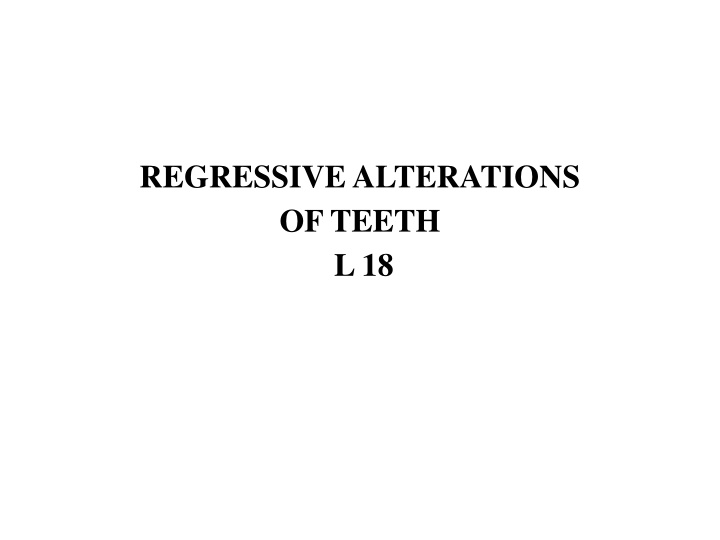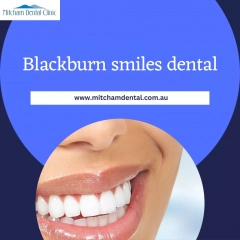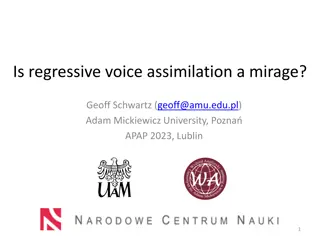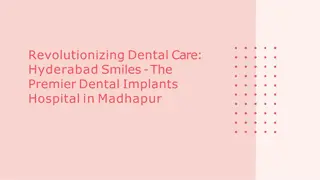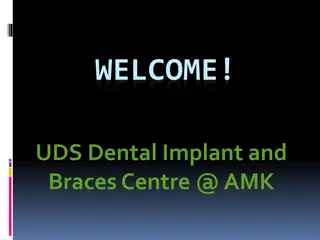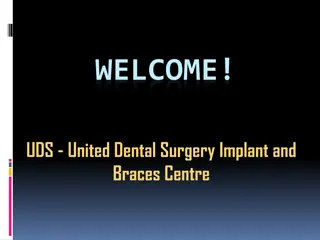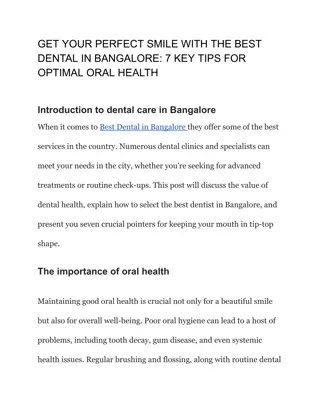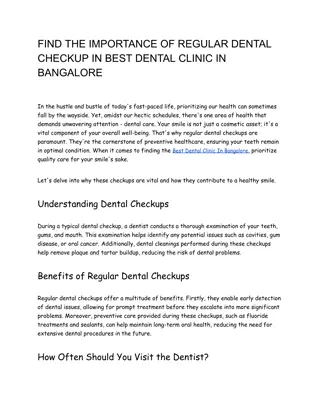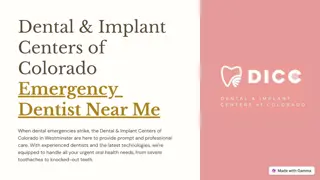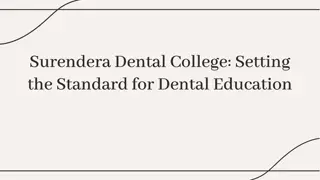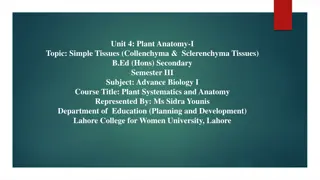Regressive Changes in Dental Tissues
Regressive changes in dental tissues, such as attrition and abrasion, are common as individuals age. Attrition results from tooth-to-tooth contact during mastication, leading to gradual reduction in cusp height. Conversely, abrasion involves pathologic wearing away of tooth substance, often on exposed root surfaces due to abrasive dentifrices. Both processes can impact the structure and health of teeth over time.
Download Presentation

Please find below an Image/Link to download the presentation.
The content on the website is provided AS IS for your information and personal use only. It may not be sold, licensed, or shared on other websites without obtaining consent from the author.If you encounter any issues during the download, it is possible that the publisher has removed the file from their server.
You are allowed to download the files provided on this website for personal or commercial use, subject to the condition that they are used lawfully. All files are the property of their respective owners.
The content on the website is provided AS IS for your information and personal use only. It may not be sold, licensed, or shared on other websites without obtaining consent from the author.
E N D
Presentation Transcript
REGRESSIVE ALTERATIONS OF TEETH L 18
Regressive changes in the dental tissues include a variety of alterations that are not necessarily related to pathological causes. Some of the changes to be considered here are associated with the general aging process of the individual
ATTRITION Attrition may be defined as the physiologic wearing a way of a tooth as a result of tooth-to-tooth contact, as in mastication. - This occurs mainly on the occlusal, incisal, and proximal surfaces of teeth. - This phenomenon is physiologic rather than pathologic, and it is associated with the aging process. The first clinical manifestation of attrition may be the appearance of a small polished facet on a cusp tip or ridge or a slight flattening of an incisal edge.
- As the person becomes older and the wear continues, there is gradual reduction in cusp height and consequent flattening of the occlusal inclined planes. - Men usually exhibit more severe attrition than women of comparable age, probably as a result of the greater masticatory force of men. - Variation also may be a result of differences in habits such as bruxism would predispose to more rapid attrition.
- The exposure of dentinal tubules and the subsequent irritation of odontoblastic processes result in formation of secondary dentin pulpal to the primary dentine, and this serve as an aid to protect the pulp from further injury.
ABRASION Abrasion is the pathologic wearing a way of tooth substance through some abnormal mechanical process. - Abrasion usually occurs on the exposed root surfaces of teeth, but under certain circumstances it may be seen elsewhere, such as on incisal or proximal surfaces.
The most common cause of abrasion of root surfaces is the use of an abrasive dentifrice. - Although modern dentifrices are not sufficiently abrasive to damage intact enamel severely, they can cause remarkable wear of cementum and dentine if the toothbrush carrying the dentifrice is injudiciously used, particularly in a horizontal rather than vertical direction. - In such cases abrasion caused by a dentifrice manifests itself usually as a V-shaped or wedge-shaped ditch on the root side of the cementoenamel junction and the exposed dentine appears highly polished
- Other less common forms of abrasion may be related to habit or to the occupation of the patient. -The habitual opening of bobby pins with the teeth may result in a notching of the incisal edge of one maxillary central incisor. - Similar notching may be noted in carpenters, shoemakers, or tailors who hold nails, tacks, or pins between their teeth. - Habitual pipe smokers may develop notching of the teeth that conforms to the shape of the pipe stem.
- The improper use of dental floss and tooth picks may produce lesions on the proximal exposed root surface, which also should be considered a form of abrasion. - The exposure of dentinal tubules and the consequent irritation of the odontoblastic processes stimulate the formation of secondary dentine similar to that seen in cases of attrition
EROSION Dental erosion is defined as irreversible loss of dental hard tissue by a chemical process that does not involve bacteria. - Dissolution of mineralized tooth structure occurs upon contact with acids that are introduced into the oral cavity from intrinsic like gastro-esophageal reflux and vomiting, - or extrinsic sources like acidic beverages, citrus fruits, medications that are acidic in nature like vitamin C preparations can also cause erosionvia direct contact with the teeth when the medication is chewed or held in the mouth prior to swallowing.
Less common sources of extrinsic erosive acids are related to occupational exposure. Chromic, hydrochloric, sulfuric and nitric acids have been identified as erosion-causing acid vapors. They are released into the work environment during industrial electrolytic processes. However current work safety standards make this type of erosion very rare.
- Erosion caused by vomiting typically affects the palatal surfaces of the maxillary teeth. - Individuals with eating disorders and consume a large amounts of acidic beverages and fresh fruits results in another source of acid exposure, primarily affecting the labial surfaces of the teeth
ABFRACTION This pathologic type of tooth loss which is mainly confined to the gingival third of the clinical crown. - It is proposed that with each bite, occlusal forces cause the teeth to flex though little. - Constant flexing causes enamel to break from the crown, usually on the buccal surface - The breakdown is depend on the magnitude, duration, direction, frequency, and location of the forces.
TRANSPARANT DENTINE Sclerosis of primary dentine is a regressive alteration in tooth substance that is characterized by calcification of the dentinal tubules. - It occurs not only as a result of injury to the dentine by caries or abrasion but also as a manifestation of the normal aging process. - If a ground section of a tooth examined by transmitted light, a translucent zone can be seen - This was readily recognized as being due to a difference between the refractive indices of the sclerotic or calcified dentinal tubules and the adjacent normal tubules.
-The exact mechanism of dentinal sclerosis or the deposition of calcium salts in the tubules is not understood, although the most likely source of the calcium salts is the fluid or dental lymph within the tubules. - The increased mineralization of the tooth decreases the conductivity of the odontoblastic processes.
DEAD TRACTS Dead tracts in dentine are seen in ground sections of teeth and are manifested as a black zone by transmitted light - This optical phenomenon is due to differences in the refractive indices of the affected tubules and normal tubules. - These tubules are not calcified and are permeable to the penetration of dyes.
SECONDARY DENTINE Secondary dentine is dentine that is formed after the complete formation of the tooth. Physiological secondary dentine is a uniform layer of dentine around the pulp chamber that is laid down throughout the life of the tooth and causing decrease in size of the pulp chamber and root canals. Reparative secondary dentine is the dentine that forms in the pulp chamber as a result of several factors like caries; which stimulates the development of natural protective measures, such as the reparative secondary dentine.
There is a considerable variation in the composition of primary and secondary dentine. The dentinal tubules that make-up dentine are generally irregular in secondary dentine and deposits contain less calcium, phosphorus, and collagenous matrix than the primary dentine.
PULP CALCIFICATION Various forms of calcification within the pulps of teeth may be located in any portion of the pulp tissue. The two chief morphologic forms of pulp calcifications are discrete pulp stones (denticles) and diffuse calcification.
Pulp stones are classified as either true or false stones. - True denticlesare made up of localized masses of calcified tissue that resemble dentine because of their tubular structure. - Actually, these nodules bear greater resemblance to secondary dentine than to primary dentine, since the tubules are irregular and few in numbers. - They are considerably more common in the pulp chamber than in the root canal
True denticles may be subdivided further according to whether or not they are attached to the wall of the pulp chamber. - Denticles lying entirely within the pulp tissue and not attached to the dentinal walls are called free denticles - while those that are continuous with dentinal walls are referred to as attached denticles .
False denticlesare composed of localized masses of calcified material, and do not exhibit dentinal tubules and appear to be made up of concentric layers or lamellae deposited around a central nidus . - The exact nature of this nidus is unknown, it is believe that it composed of cells, as yet unidentified, around which is laid down a layer of reticular fibers that subsequently calcify.
The false denticle also may be classified as free or attached. - As the concentric deposition of calcified material continues, it approximates and finally is in apposition with the dentinal wall. Here it may eventually become surrounded by secondary dentine, and it is then referred to as an interstitial denticle .
- Diffuse calcifications are most commonly seen in the root canals of teeth ; the incidence appears to increase with the age of the persons.
RESORPTION OF TEETH Resorption of teeth occurs in many circumstances other than the normal process associated with the shedding of deciduous teeth. The roots of permanent teeth may undergo resorption in response to a variety of stimuli; may begin either on the external surface or inside the tooth
The causes of external resorption are: 1.Periapical inflammation arising as a result of pulpal infection or trauma occasionally causes subsequent resorption of the root apex if the inflammatory lesion persists for a sufficient period of time. Osteoclasts appear responsible for the root resorption. 2. The reimplantation, or transplantation, of teeth almost invariably results in severe resorption of the root. The tooth root is resorbed and replaced by bone, producing an ankylosis.
3. The resorption of roots may be brought about by tumors or cysts, and appears to be caused by a pressure phenomenon. 4. Excessive mechanical or occlusal forces which are mostly that applied during orthodontictreatment.
5.Teeth that are completely impacted or embedded in bone occasionally will undergo resorption of the crown or of both crown and root. Impacted teeth also may cause resorption of the roots of adjacent teeth without being resorbed themselves. This is particularly common in the case of a horizontally or mesio- angularly impacted mandibular third molar impinging on the roots of the second molar. 6.Idiopathic resorption occurswithout any obvious cause
The causes of internal resorption (pink tooth) are: Tooth resorption that begins centrally within the tooth, apparently initiated, in most cases, by a peculiar inflammatory hyperplasia of the pulp. The cause of the pulpal inflammation and subsequent resorption of tooth substance is unknown, although an obvious carious exposure and accompanying pulp infection are sometimes present.
- Most cases of internal resorption present no early clinical symptoms. - The first evidence of the lesion may be the appearance of a pink area on the crown of the tooth, which represents the hyperplastic, vascular pulp tissue filling the resorbed area and showing through the remaining overlying tooth substance. - Complete perforation in crown or root is not an uncommon finding if the tooth is left untreated.
- In the event that the resorption begins in the root, there are no significant clinical findings. - Radiographically, the involved tooth exhibits a round or ovoid radiolucent area in the central portion of the tooth, associated with the pulp.
Histological features shows proliferation of the pulp tissue filling the defect. The resorption is of an irregular lacunar variety showing occasional osteoclasts or odontoclasts. The pulp tissue usually exhibits a chronic inflammatory reaction.
HYPERCEMENTOSIS (Cementum hyperplasia) Is a non-neoplastic condition in which excessive cementum is deposited in continuation with the normal radicular cementum. Hypercementosis may be regarded as a regressive change of teeth characterized by the deposition of excessive amounts of secondary cementum on root surfaces commonly involves the entire root area, in some instances the cementum formation is focal usually occurring only at the apex of a tooth.
The etiology of deposition of excessive amounts of cementum: Accelerated elongation of a tooth owing to loss of an antagonist. Inflammation about a tooth. Paget s disease of bone (generalized hypercementosis). In nonfunctioning teeth, including embedded or impacted teeth. On occasion, occlusal trauma results in mild root resorption. Such resorption is repaired by secondary cementum. Root fracture is also repaired on occasion by deposition of cementum between the root fragments as well as on their periphery. Unknown etiology.
CEMENTICLES Cementicles are small foci of calcified tissue, not necessarily true cementum, which lie in the periodontal ligamentof the lateral and apical root areas. The exact cause for theirformation is unknown, but the most common manner in which cementicles develop is by calcification of nests of epithelial cells, i.e. epithelial rests, in the periodontal ligament as a result of degenerative change. These bodies enlarge by further deposition of calcium salts
The pattern of calcification often gives the appearance of a circular lamellated structure causing roughened globular outline to the root surface. Cementicles may also appear to arise through calcification of thrombosed capillaries in the periodontal ligament.
